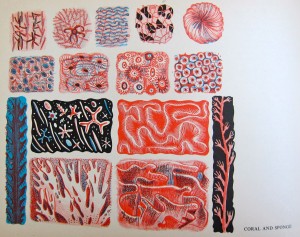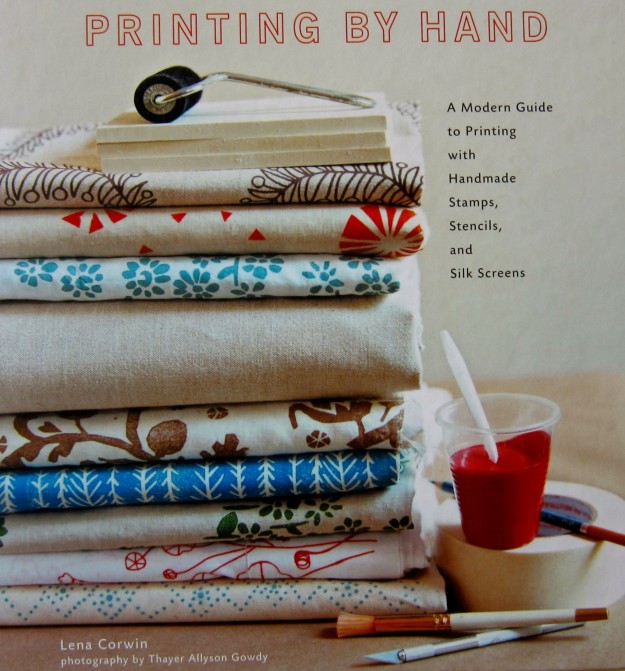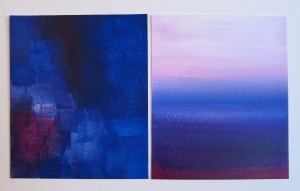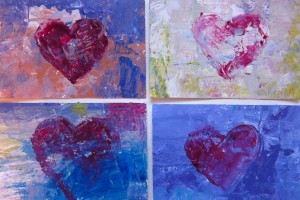Writing this post is giving me a blog identity crisis. I miss having an active place to write about textiles (in addition to my Facebook Slow Cloth page) and I’m realizing I’m not satisfied with any of my blogs. Is the answer to have one blog that covers all my interests, and post often? I’m going to have to ponder some kind of reorganization, because I’m not writing enough.
But here we are. This seems to be the best place for now for this post — I’ve wanted to begin cataloguing my textile and art books for a while. I have a pretty great collection; my love for how-to books and art books goes back a long way. There can also a shadow side to this collecting: I had years when I wasn’t making much of anything at all, and somehow buying the books, and then becoming an editor for them, became my substitute. Let me be your Horrible Warning: don’t fall prey to that.
When I first became interested in pattern and surface design, there weren’t many places to study, so I bought every book I came across, used or new. Today online design-and-print sites including Spoonflower and excellent online teaching sites such as Pattern Observer have completely democratized textile design and the line between professional and amateur has been dissolved. So these days there are many beautiful fabrics available from creative and original designers, professional and student alike, and there are also many that are so similar and derivative and elementary that you can easily get a bad case of cute-print fatigue.
To broaden your design resources, exploring traditional gouache painting or some of the great hand-printing techniques in old and new design books can inspire expressive and individual design. Here are some of the books I’ve collected. While quite a few of my books are downright vintage, you can also find many new textile print design books that cater to digital design. But if there’s a rich and beautiful tradition to be found, it’s in the centuries of textile design and pattern decoration that humans have devised, so check out some of these older books too.
-
Design for Artists and Craftsmen, Louis Wolchonok, 1953.


Design for Artists and Craftsmen by Louis Wolchonok, 1953, Dover Publications. Page Detail.
This is a crazy book! The inside cover calls it “Most thorough book ever written on the creation of art motifs and design.” One of the many books that Dover published in hardcover before it turned to paperback clip-art books, it’s full of quirky, strange drawings that evolve with many variations into highly stylized forms. Many exercises to get you going with plant, animal, bird, flower, geometric, and man-made forms.
-
A World of Pattern, Gwen White, 1958.

A World of Pattern by Gwen White, 1958, Charles T. Branford Company

A World of Pattern by Gwen White, Page Detail 1

A World of Pattern by Gwen White, Page Detail
This is a beautiful book that I found in a used bookstore for $4.50. The color plates are fantastic, and each is backed with a black-and-white plate that, when held up to the light, shows the color plate behind it as a decorative pattern within the line drawing. From the introduction: “How curious it is that so many man-made patterns look alike, when all around us everywhere are new patterns waiting to be discovered.”
-
Design on Fabrics, Meda Parker Johnston and Glen Kaufman, 1967

Design on Fabrics by Meda Parker Johnston and Glen Kaufman, 1967, Reinhold Publishing

Design on Fabrics by Meda Parker Johnston and Glen Kaufman, 1967, Reinhold Publishing. Title page.

Design on Fabrics by Meda Parker Johnston and Glen Kaufman, 1967, Reinhold Publishing. Page Detail 3.

Design on Fabrics by Meda Parker Johnston and Glen Kaufman, 1967, Reinhold Publishing. Page Detail 1.

Design on Fabrics by Meda Parker Johnston and Glen Kaufman, 1967, Reinhold Publishing. Page Detail 2.
Johnston and Kaufman were textile art professors who taught at various times at the School of the Art Institute of Chicago, Cranbrook Academy, and other schools. This book is well worth seeking out and having in your library, and I believe is available digitally through Google Books. Like many other textile design and surface design books of the era, it was intended as a teaching tool/textbook and is full of both history and technique. There’s a good tie-dye/shibori section. Most of the illustrations are black and white but you’ll find no shortage of design inspiration here.
-
Principles of Pattern Design, Richard M. Proctor, first published 1970, re-published 1990.

Principles of Pattern Design by Richard M. Proctor, 1990 republication of 1970 edition, Dover

Principle of Pattern Design by Richard M. Proctor, 1990 republication of 1970 edition, page detail.
This book simply and intelligently explores units of pattern design in detail, from the square network to the ogee network. Full of hand-drawn examples and inspiration.
-
Printed Textiles: A Guide to Creative Design Fundamentals, Terry A. Gentille, 1982.

Printed Textiles by Terry A. Gentille, 1982, Prentice-Hall

Printed Textiles by Terry A. Gentille, 1982, Prentice-Hall, page detail.
This is indeed a book of fundamentals for textile design. In 1982, rubber cement and compasses were still absolutely necessary graphic design tools, and this book instructs you thoroughly in building repeats and drawing and painting croquis as it was done then. This book was intended as a working guide for students who intended to become professional textile designers.
-
Surface Design for Fabric, Richard M. Proctor and Jennifer F. Lew, 1984.

Surface Design for Fabric by Richard M. Proctor and Jennifer F. Lew, 1984, University of Washington Press

Surface Design for Fabric by Richard M. Proctor and Jennifer F. Lew, 1984, University of Washington Press. Page detail.
I think this book launched and fueled the passion of many a contemporary surface designer and art-cloth maker. Proctor and Lew both taught at the University of Washington, whose press published this softbound guide. Among other things, it’s rich with detailed lessons for using fiber-reactive and other dyes in inventive ways. There are sections on resist techniques, printing with inks and dyes, batik, and developing imagery. Together with the gorgeous catalogs/instructional booklets that the now-closed Seattle fiber arts store Cerulean Blue used to send in the mail, this book positioned the Pacific Northwest as a hotbed of surface design.
-
Textiles: A Handbook for Designers (rev. edition), Marypaul Yates, 1986, 1996.

Textiles: A Handbook for Designers by Marypaul Yates. Rev. edition, 1996, 1986, W.W. Norton & Co.

Marypaul Yates is the principal and founder of Yates Design Inc. and has a long and accomplished career in textile design. This book is a reference and textbook written, Yates says in the foreword, to teach the techniques that for so long had been passed down by word of mouth. Although many of the images in the book are black and white, it’s full of beautiful hand-drawn and hand-painted designs and detailed descriptions of analog rendering techniques and printing methods.
-
Textile Print Design: A how-to-do-it book of surface design, Richard Fisher and Dorothy Wolfthal, 1987.

- Textile Print Design by Richard Fisher and Dorothy Wolfthal, 1987, Fairchild Publications

Textile Print Design by Richard FIsher and Dorothy Wolfthal, 1987, Fairchild Publications. Page detail.
Fisher and Wolfthal were professors in the Textile & Surface Design Department of Fashion Institute of Technology when this book was published, and intended it as a beginner’s guide to a career in surface design. The book is a bit dated and most of the photos are black and white, but it’s full of information on tools, supplies, techniques, research methods, and professional career guidance for young designers.
-
The Textile Design Book: Understanding and creating patterns using texture, shape, and color, Karin Jerstorp and Eva Kohlmark, 1986 (English translation 1988).

The Textile Design Book by Karin Jerstorp and Eva Köhlmark, 1986, English translation 1988, Lark Books.

The Textile Design Book by Karin Jerstorp and Eva Kohlmark, page detail
This book is fresh and full of ideas for contemporary, colorful pattern and textile design. Working with simple geometric shapes and repeats, a handmade aesthetic, and fun historical references, this book is full of inspiration and charm on every page.
-
Fabulous Fabrics of the 50s (And Other Terrific Textiles of the 20s, 30s, and 40s), Gideon Bosker, Michele Mancini, and John Gramstad, 1992.

Fabulous Fabrics of the 50s by Gideon Bosker, Michele Mancini, John Gramstad, 1992, Chronicle Books

Fabulous Fabrics of the 50s by Gideon Bosker, Michele Mancini, John Gramstad, 1992, Chronicle Books, page detail 2

Fabulous Fabrics of the 50s by Gideon Bosker, Michele Mancini, John Gramstad, 1992, Chronicle Books, page detail
This is one of those gorgeous gift books that Chronicle Books publishes, more reference and inspiration than instruction, but it’s so much fun for anyone who loves mid-century design that I had to include it. From cowboy prints to Hawaiian barkcloth to the organic shapes we immediately identify with the era, it’s full of treasures in nice glossy full-color photos accompanied by excellent text.
-
Designing with Pattern and Design Sources for Pattern, Jan Messent, 1992.

Designing with Pattern + Design Sources for Pattern by Jan Messent, 1992, Crochet Design

Designing with Pattern + Design Sources for Pattern by Jan Messent, 1992, Crochet Design, page detail.
These two notebook-like books, just 40 pages each, by prolific textile artist and embroiderer Jan Messent are really good. Hand-drawn illustrations show you how Messent sees pattern everywhere in the world around her and translates it to designs that can be the basis of repeat patterns, stitching, or other uses. I don’t know if Messent is still with us but she wrote quite a few books, with titles like Knitted Historic Figures and Designing for Embroidery from Ancient and Primitive Sources. If you stumble across any of them, I’d grab them.
-
Textile Design: The Complete Guide to Printed Textiles for Apparel and Home Furnishing, Carol Joyce, 1993.

Textile Design: The Complete Guide to Printed Textiles for Apparel and Home Furnishing by Carol Joyce, 1993, Watson-Guptill

Textile Design: The Complete Guide to Printed Textiles for Apparel and Home Furnishing by Carol Joyce, 1993, Watson-Guptill, page detail 2

Carol Joyce, a textile designer and instructor at The School of Visual Arts, contributed this reference book/practicum in 1993 to the textile design field; most of the images are oriented toward home decor fabrics rather than apparel fabrics. Many instructions, techniques, ideas, and fabric samples make an excellent resource book for designers.
-
The Victoria & Albert Museum’s Textile Collection: British Textile Design from 1940 to the Present, 1999; and V&A Pattern: Indian Florals, 2009 (with CD).

The Victoria & Albert Museum’s Textile Collection: British Textile Design from 1940 to the Present, 1999, V&A Publications

V&A Pattern: Indian Florals, 2009, V&A Publishing. WIth CD.
These are two examples of beautiful reference books, of which there are many, that you can go a little nuts collecting. London’s V&A Museum has an especially wonderful collection of these books, and you’re limited only by your budget in amassing them.
-
Twentieth-Century Pattern Design: Textile and Wallpaper Pioneers, Lesley Jackson, 2002.

Twentieth-Century Pattern Design: Textile and Wallpaper Pioneers by Lesley Jackson, 2002, Princeton Architectural Press
I’m sad to say that this book does not belong to me. A friend loaned it to me and I’m loathe to return it — it’s just gorgeous. More than 200 pages of full-color images of the best pattern and textile design from all over the globe, this is just a beautiful reference book. See if your library has it or put it on your wish list.
-
Print, Pattern and Colour for Paper and Fabric, Ruth Issett, 2007.

Print Pattern & Colour by Ruth Issett, 2007, Batsford
I love textile artist Ruth Issett‘s work. She goes all in with color and pattern in a very experimental, free-form way. This guide to one-off art fabric, printing, and surface design will send you off in creative, loose mark-making, printing, dyeing, and idea development.
-
Printing by Hand: A Modern Guide to Printing with Handmade Stamps, Stencils, and Silk Screens, Lena Corwin, 2008.

Printing by Hand by Lena Corwin, 2008, Stewart Tabori & Chang STC Craft
This book has been very popular, and deservedly so, with textile artists and designers. Instructions and projects will get you started making and using simple hand-printed designs in Lena Corwin‘s lovely modern and spare aesthetic.
-
A Field Guide to Fabric Design: Design, Print & Sell Your Own Fabric • Traditional & Digital Techniques for Quilting, Home Dec & Apparel, Kimberly Kight, 2011.

A Field Guide to Fabric Design by Kimberly Kight, 2011, C&T Publishing
This is the most recent book that I have, though by no means the most recent book published on textile and fabric design (and I believe that Spoonflower has a book coming out soon too). As the subtitle(s) indicate, it’s a full-service guide to modern fabric design methods, both analog and digital, aimed at young independent designers who want to dive in. There is information on copyright, instructions for Photoshop and other software methods for fabric design, and building collections, and more.
Beyond books, there are a couple of online resources I want to mention. Michelle Fifis’s PatternObserver is a fantastic resource with online classes, a great blog, and just a lot of good and generous advice. Pattern Pulp is good online inspiration for contemporary pattern across the board. Spoonflower is a great place for both beginners and more experienced designers to explore digital printing and see what others are doing, and they’re adding more base fabrics all the time (I’m not a fan of all the contests but if you like that sort of thing, it’s available to you). Pattern People has good resources for sale and a good blog.
###


























































